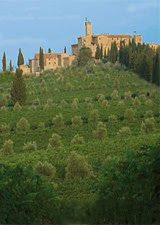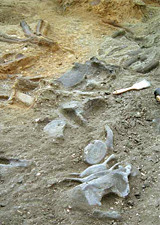 Fossils turn up in the most unusual places. Simone Casati, an amateur paleontologist, was exploring the famed vineyards of Italian winemaker, Castello Banfi, when he came across a small piece of bone poking out of the soil. He started digging and realized that he had unearthed more then he had e anticipated: a 10m (33ft) long skeleton of an ancient whale.
Fossils turn up in the most unusual places. Simone Casati, an amateur paleontologist, was exploring the famed vineyards of Italian winemaker, Castello Banfi, when he came across a small piece of bone poking out of the soil. He started digging and realized that he had unearthed more then he had e anticipated: a 10m (33ft) long skeleton of an ancient whale.The rich soil of the vineyards was laid down five millions years ago in the Pliocene, a time when Tuscany was covered by a warm, shallow sea rich in fauna.
 The skeleton, which resembles a modern rorqual whale, is almost complete and well preserved. It belongs to the group of large baleen whales that includes the blue, humpback, and fin whales.
The skeleton, which resembles a modern rorqual whale, is almost complete and well preserved. It belongs to the group of large baleen whales that includes the blue, humpback, and fin whales.
The excavation team, led by palaeontologist Menotti Mazzini of the University of Florence, are working on a month long excavation, after which the skeleton will be removed to be cleaned and restored. The winery has requested permission from Italy's Department of Cultural Heritage to host the fossil and display it to the public in Banfi's museum.
Cristina, M. March 23, 2007. Ancient Whale Fossil Uncovered in Tuscan Vineyard. National Geographic News.


